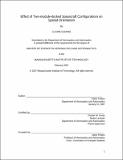| dc.contributor.advisor | Charles M. Oman. | en_US |
| dc.contributor.author | Cizaire, Claire (Claire Jia Ling) | en_US |
| dc.contributor.other | Massachusetts Institute of Technology. Dept. of Aeronautics and Astronautics. | en_US |
| dc.date.accessioned | 2007-08-29T20:39:34Z | |
| dc.date.available | 2007-08-29T20:39:34Z | |
| dc.date.copyright | 2007 | en_US |
| dc.date.issued | 2007 | en_US |
| dc.identifier.uri | http://hdl.handle.net/1721.1/38647 | |
| dc.description | Thesis (S.M.)--Massachusetts Institute of Technology, Dept. of Aeronautics and Astronautics, 2007. | en_US |
| dc.description | Includes bibliographical references (leaves 45-46). | en_US |
| dc.description.abstract | This thesis used virtual reality techniques to investigate how differences in visual vertical direction of two docked spacecraft affect the ability of a person in one module to mentally visualize the relative orientation of the other module, and spatial relationships of surfaces in it. Spacecraft and space station modules are typically connected differently in space from the way they would be in training simulators on Earth. The local visual vertical is the direction that appears to be "up" as defined by panel and rack orientation, labeling, and placement. In space, the local visual verticals of adjacent modules are not always consistently aligned and astronauts say they find it hard to orient themselves within those configurations. We investigated how relative module orientation determines performance in a spatial memory and visualization task. An experiment compared six different attachment configurations of two modules. Subjects (n = 20) wearing a color stereo head mounted display first learned the interiors of two modules separately. They then learned six flight configurations sequentially. In each configuration, subjects located in the first module were shown one "cue" wall in that module, so they could determine their orientation, and were then asked to visualize, place and orient a "target" wall within a wireframe view of the adjacent second module. | en_US |
| dc.description.abstract | (cont.) The total time to respond to each trial was recorded, along with the percentage of correct responses, and the subject's head orientation. The analysis of time to respond and percentage of correct responses showed that certain configurations were statistically significantly different. As expected, the easiest configurations were "terrestrial like" where the visual verticals of the two modules were co-aligned. Including a 180 deg pitch between the modules made the task harder. The hardest were those that included a 90 deg pitch - in which the local visual verticals of the two modules were orthogonal. Comparing the easiest (terrestrial like) configurations with hardest, subjects needed 3 seconds more to orient and accomplish the task. This represents a significant amount of time given that we perform this task without much thinking about it and almost instantaneously on Earth. Subjects relied heavily on the visual verticals, and often tilted their heads toward alignment with the local visual vertical. Performance could be predicted, based on the number of pitches and yaws relating the two modules in the configurations tested. Supported in part by NASA Cooperative Agreement NCC9-1 with the National Space Biomedical Institute. | en_US |
| dc.description.statementofresponsibility | by Claire Cizaire. | en_US |
| dc.format.extent | 81 leaves | en_US |
| dc.language.iso | eng | en_US |
| dc.publisher | Massachusetts Institute of Technology | en_US |
| dc.rights | M.I.T. theses are protected by copyright. They may be viewed from this source for any purpose, but reproduction or distribution in any format is prohibited without written permission. See provided URL for inquiries about permission. | en_US |
| dc.rights.uri | http://dspace.mit.edu/handle/1721.1/7582 | |
| dc.subject | Aeronautics and Astronautics. | en_US |
| dc.title | Effect of two-module-docked spacecraft configurations on spatial orientation | en_US |
| dc.title.alternative | Effect of 2-module-docked spacecraft configurations on spatial orientation | en_US |
| dc.type | Thesis | en_US |
| dc.description.degree | S.M. | en_US |
| dc.contributor.department | Massachusetts Institute of Technology. Department of Aeronautics and Astronautics | |
| dc.identifier.oclc | 163142296 | en_US |
